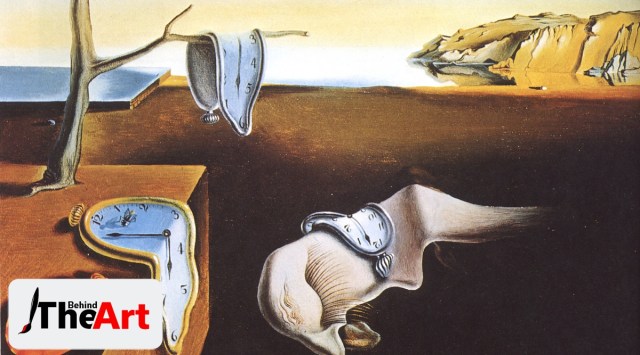- India
- International
Behind the Art: Why is The Persistence of Memory by Salvador Dalí one of the most recognised artworks in history?
This painting has several nicknames such as ‘Melting Clocks’ and ‘The Soft Watches’ and is constantly referred to in popular culture. But what does the painting signify and why did Dalí decide to paint clocks?
 The Persistence
of Memory by Salvador Dalí. Source: Museum of Modern Art
The Persistence
of Memory by Salvador Dalí. Source: Museum of Modern Art Known as one of the most recognisable works of Surrealism, The Persistence of Memory was painted by artist Salvador Dalí in 1931. It is known to be worth about $150 million and was donated by an anonymous buyer to the Museum of Modern Art in New York City, USA in 1934. For a painting to be bought and displayed at a prestigious museum in a short period shows how important it is to the art world. This painting has several nicknames such as ‘Melting Clocks’ and ‘The Soft Watches’ and is constantly referred to in popular culture. But what does the painting signify and why did Dalí decide to paint clocks?
Story Behind the Art
This surrealist piece of art introduced the concept of a pocket watch melting for the first time. It is based on Dalí’s theory of softness and hardness. The soft watches are in a way an unconscious symbol of the relativity of space and time. This suggests that Dalí was incorporating the understanding of the world introduced by Albert Einstein’s theory of special relativity.
When asked if this was true. Dalí said the soft watches were not inspired by the theory of relativity but by the surrealist perception of a Camembert melting in the sun. An orange clock at the bottom left of the painting is covered in ants and those who follow the artwork of Dalí, they know that he often used ants in his paintings as a symbol of decay. He even painted a fly which is seen sitting on the watch next to the orange watch and it appears to be casting a human shadow as the sun hits it.
The entire painting depicts imagery that is more likely to be found in dreams rather than in waking consciousness. And it is not just the clocks that are doing the job of painting this bizarre dream for the viewers. There is also a strange ‘monster’ or a human figure in the middle of the painting. Dalí was perhaps aiming to represent himself through his work and painting this ‘self-portrait’ of sorts to express his inner thoughts. However, some say that the creature seems to be based on a figure from the Paradise section of Hieronymus Bosch’s The Garden of Earthly Delights, which Dalí was quite fond of. The theory that this is symbolism for Dalí and his dream in which he experienced the passing of time is more probable if one looks at Dalí’s other works. He famously once said, “the difference between a madman and me is that I am not mad”. This was after it was discovered that a year before he painted this artwork, he formulated a unique method through which he self-induced psychotic hallucinations to create art. Unlike other artists who use substances to achieve their end goals on a canvas, Salvador Dalí induced himself to hallucinate to access his subconscious while making art, a process he called the ‘paranoiac-critical method’. On the results of this process, he wrote, “I am the first to be surprised and often terrified by the images I see appear upon my canvas. I register without choice and with all possible exactitude the dictates of my subconscious, my dreams….” By rendering these images so meticulously, he nurtured the illusion that they might exist in the real world.

Why is the painting so well known?
One has to study art as well as psychology perhaps to understand why this painting is so well known. Dali’s purpose of plunging the viewer into a dreamlike and strange universe where hard and soft surfaces coexist makes this painting a well-talked-about subject. It is the surreality of the painting that makes it so well-liked and because Dalí chose to paint familiar objects in unfamiliar ways instead of using hasty brushstrokes and colours, the art lovers truly appreciate the precision of the artist and his artistry. Another reason why this painting is so famous is that it combines three art genres – still life, landscape and self-portrait. The self-portrait practice can somewhat be seen in another painting by Dalí called The Great Masturbator which he painted in 1929.
However, the figure in The Persistence of Memory appears to be either sleeping or dead. If one were to look into the historical context of the painting, it would seem that the broken branch in the painting, which art experts identify as an olive tree in the context of other Dali artworks, represents the demise of ancient wisdom as well as the death of peace. According to historians, this reflects the political climate between the two World Wars as well as the unrest leading to the Spanish Civil War in Dali’s native country. This painting successfully opposes Surrealism to reality and questions the ineluctability of time which has made it one of the most recognisable artworks in the world.
Next up in Behind the Art: Why is Vincent van Gogh’s Le café de Nuit (The Night Café) so significant?
📣 For more lifestyle news, follow us on Instagram | Twitter | Facebook and don’t miss out on the latest updates!
May 03: Latest News
- 01
- 02
- 03
- 04
- 05



































